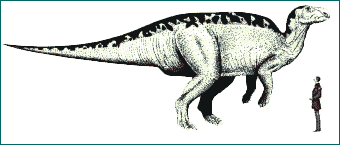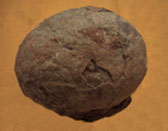
|
|||||||||
|
|
|||||||||
|
|
|
Hadrosaurus
The Hadrosaurus, although huge, was a herbavore and not very ferocious. Nearly as tall as a two-story building, the Hardosaurus weighed up to four tons and was a member of the dinosaur family known as "duckbills" because of the bird-like nature of their jaws and skull structure. The Hadrosaurus could grow up to 30 feet long from the tip of its nose to the tip of its tail. It's demeanor could be compared to that of a cow. It was a plant eater that browsed leaves and branches along the marshes and shrub lands of the Atlantic coast of North America and other marshlands of the Cretaceous Era. It was a good swimmer and could have ventured out into the water a substantial distance from shore. Duckbills lived and traveled in herds. They laid eggs in nests. Some paleontologists believe they protected the eggs until hatched and then continued to nurture the brood for a period of time, just as birds do. It is easy to imagine how the edges of conifer forests along the Cretaceous coast of Pennsylvania were once filled with duckbill dinosaurs. One of these Hardosaurs most likely fell into fast moving water and died. Its body floated out to sea, where it sank and was quickly covered in mud and sediment. After the flesh decayed, the bones absorbed minerals, surviving intact as a skeleton until about 70 million years later when William Parker Foulke, a Haddonfield, New Jersey workman, pulled it from the sticky clay, moved it into the sunlight and wondered aloud what it could possibly be. This Hadrosarus became the first complete dinosaur skeleton ever to be discovered intact. To learn more about the Hadrosaurus, visit this website http://www.levins.com/dinosaur.html
|
|||||||
|
|
|||||||||

